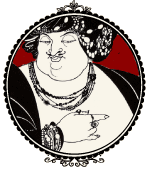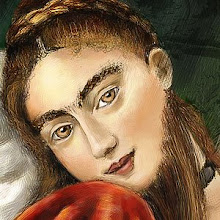Rated R for Raucous Content
On the evening of October 30th 1501, Johanna Burchard made his way through Rome’s windy streets and followed the smell of roasting pig flesh and warmed chestnuts wafting out of the Vatican Palace. As Master of the Ceremonies, he was expected to attend every fete hosted by Pope Alexander VI and his son Cesare Borgia, but he had grown tired of the endless parties. Night after night, the Borgias celebrated the forthcoming marriage between the pope’s daughter, Lucrezia and her betrothed, Alfonso d’este.
As Burchard entered the dimly lit apartments, the low sounds of swishing velvet enveloped him as fifty beautiful courtesans beckoned him inside. Pearls, rubies and emeralds coiled around their necks and down their low cut gowns like overgrown vines strangling a tree. Rubbing his tired eyes, Burchard recognized the sumptuously dressed blonde, known as Fiammetta, strumming her lute above the banquet table. She was Cesare’s mistress and was rumored to be so rich that she had commissioned an entire fresco to be painted in the church of S. Agostino. Across the room a plump, golden haired beauty with reddened earlobes sang before her admiring crowd, demurely lowering her eyes to see who was watching. She was known as Imperia, the most beautiful women he had ever laid eyes on and the cherished muse of Raphael. The rest of the women were nestled in corners flirting with Rome’s finest nobleman, only occasionally lifting their heads to let their silver bell laughter fill the room.
These women were not your typical meretrici (prostitutes), but members of a ruling class called cortigiana (courtesans) and they were not just beautiful ornaments, but educated in art, music, dance, poetry and most importantly, conversation. Yet, if we are to believe Burchard’s account, their greatest talents were in the art of making love. In the darker pages of his diary, Burchard writes:
“After supper the lighted candelabra which had been on the table were placed on the floor, and chestnuts thrown among them which the prostitutes had to pick up as they crawled between the candles. The Pope, the Duke and Lucrezia, his sister, were present looking on. At the end they displayed prizes of silk mantles, boots, and other objects which were promised to whomsoever should have made love to these prostitutes the greatest number of times. The prizes were distributed to the winners according to the judgement of those present.”(1)
Understandably, the pope failed to make it to mass the next day.
Burchard (who was no friend of the Borgia) is the only person to relay such louche details so historians have long wondered if the famous “banquet of the chestnuts” is perhaps a little exaggerated. Still, we can imagine that your typical Borgia get-together probably did not have the pin the tail on the donkey type of party games. We also can only guess at who attended this infamous orgy. Cesare, Lucrezia and Alexander were there, but we do not know if their famed mistresses attended. One thing is for certain. Any party thrown by the diabolical Cesare Borgia would have had the most desired women at his beck and call.
The reign of the Borgias was the golden age for courtesans. Wealthy courtesans rode through the streets throwing gilded eggs filled with rose water or coyly sang from their windows down to their admirers below. Prostitution became so ubiquitous that Pietro Aretino’s (best remembered for his contributions to the
Book of the Prick) cantankerously observed that “Rome always has been and ever will be….the town of whores.”
Aretino’s views may have been colored by his animosity toward the Romans after he was forced to flee Venice. Rome was certainly not the only city where prostitution was rampant. Venice especially became celebrated for the classical beauty of their art, architecture and women. Estimates vary, but there were roughly 11,000 prostitutes servicing 300,000 inhabitants.

With so many prostitutes and courtesans, how could a typical traveler tell the difference between a puttana (whore) and respectable matrona (married woman)? Your lower class courtesans were usually easier to spot. They dressed like men wearing braghesse (codpieces) and dresses cut so low that it revealed their breasts. Most fantastic of all were the shoes. Venetian prostitutes wore shoes that would have intimidated even the most daring super models of today. Called pianelles, they were made of wood and elevated the wearer as much as a foot above the ground. You can see from the picture above that navigating a dirty street would be next to impossible without the help from a suitor or two.
Your higher priced onesta cortegiana (honest courtesan) dressed so well that it would often be very difficult to tell them apart from the rest of patriarchal society. This was a problem not just in Venice and Rome, but throughout Italy. It was especially problematic when they attended mass. You have to remember that church was the fashion runway of the day and often the only chance most women got to show off their wares. So we can imagine that if you were a respectable noble woman and some hussy pranced by you wearing more glitter than a Christmas tree that it would start to unnerve you. Eventually, the class wars led to the upstanding socielities of Florence to put pressure on the Grand Duke to enact sumptuary laws for all courtesans. Prostitutes were not allowed to wear gold, silver, gemstones, or silk. That meant no fancy pearls. (This led to the practice of prostitutes flashing their necks to show that they were unadorned.) Florence’ prostitutes were also required to wear a yellow veil with a big, tacky yellow stripe on it known as “the whore’s mirror.” If you wanted to find a prostitute in Florence, you just had to follow the yellow stripes like a road map.

Now dear reader, in these tough economic times, I hope you can relate to the sentiment that everyone has to make a living. Telling a courtesan that she can’t wear her pearls is kind of like telling a fire fighter he can’t use a hose. Most courtesans simply ignored the sumptuary laws or were granted special dispensations to dress as they please. Such was the case with famed courtesan and prolific writer, Tullia d’ Aragona who pulled a few “favors” from the Duke and was allowed to dress like a noblewoman. As educated women and skillful conversationist, most courtesans sought to distance themselves from the common prostitutes. Lucieta Padovana was indignant regarding the sumptuary laws arguing, “non reptandose meretrice” but instead a “cortesana” (2). (Basically…I am not some common prostitute. I am a courtesan. Big difference. )
Still sumptuary laws persisted and often became difficult to keep track of. In Florence, prostitutes were required to wear gloves, wooden high heels, and a bell on her headpiece (assumingly so everyone could hear her siren jingle coming.) In Bergamo 1490, a saffron colored scarf was required. In Piedmonth, they had to decorate their headgear with horns. In Milan, they were required to wear white in 1492, black in 1498, white again in 1541. You could see how all of this would get confusing for the common traveler. As they say, necessity is the mother of invention, or at least it was for Crispijn de Passe the elder whose best seller, the Miroir (1603) became the defacto guide for seeking out fashionable courtesans.
to be continued in Part 3 of the Fashionable prostitute…
Notes:
(1) Bradford, p. 121
(2) Rosenthal, p. 72
Sources and Further Reading:
Bradford, Sarah. Lucrezia Borgia: Life, Love and Death in Renaissance, Penguin 2005
Rosenthal, Margaret. The Honest Courtesan, University of Chicago Press, 1993
Rosenthal, Margaret F. and Jones, Ann Rosalind. The Clothing of the Renaissance World, Thames and Hudson, 2008
 Today we have the glossy pages of Vogue and Glamour to find the most fashionable clothing, but during the Renaissance, courtesans were the super models of their day. The first costume books, called alba amicorum, contained detailed information on the fashion tastes of these leading ladies. As discussed in last week’s post, sumptuary laws proved useless in distinguishing a noble woman from a courtesan. Thus, the yellow pages of prostitutes, catalogs such as Il Catalogo di tutte le principale et piu honorate cortigiana di Venezia required courtesans to register with their name, addresses, procuress (sadly, usually dear mom) and fees. (Famed courtesan Veronica Franco charged six scudi for just a kiss. )
Today we have the glossy pages of Vogue and Glamour to find the most fashionable clothing, but during the Renaissance, courtesans were the super models of their day. The first costume books, called alba amicorum, contained detailed information on the fashion tastes of these leading ladies. As discussed in last week’s post, sumptuary laws proved useless in distinguishing a noble woman from a courtesan. Thus, the yellow pages of prostitutes, catalogs such as Il Catalogo di tutte le principale et piu honorate cortigiana di Venezia required courtesans to register with their name, addresses, procuress (sadly, usually dear mom) and fees. (Famed courtesan Veronica Franco charged six scudi for just a kiss. )


























